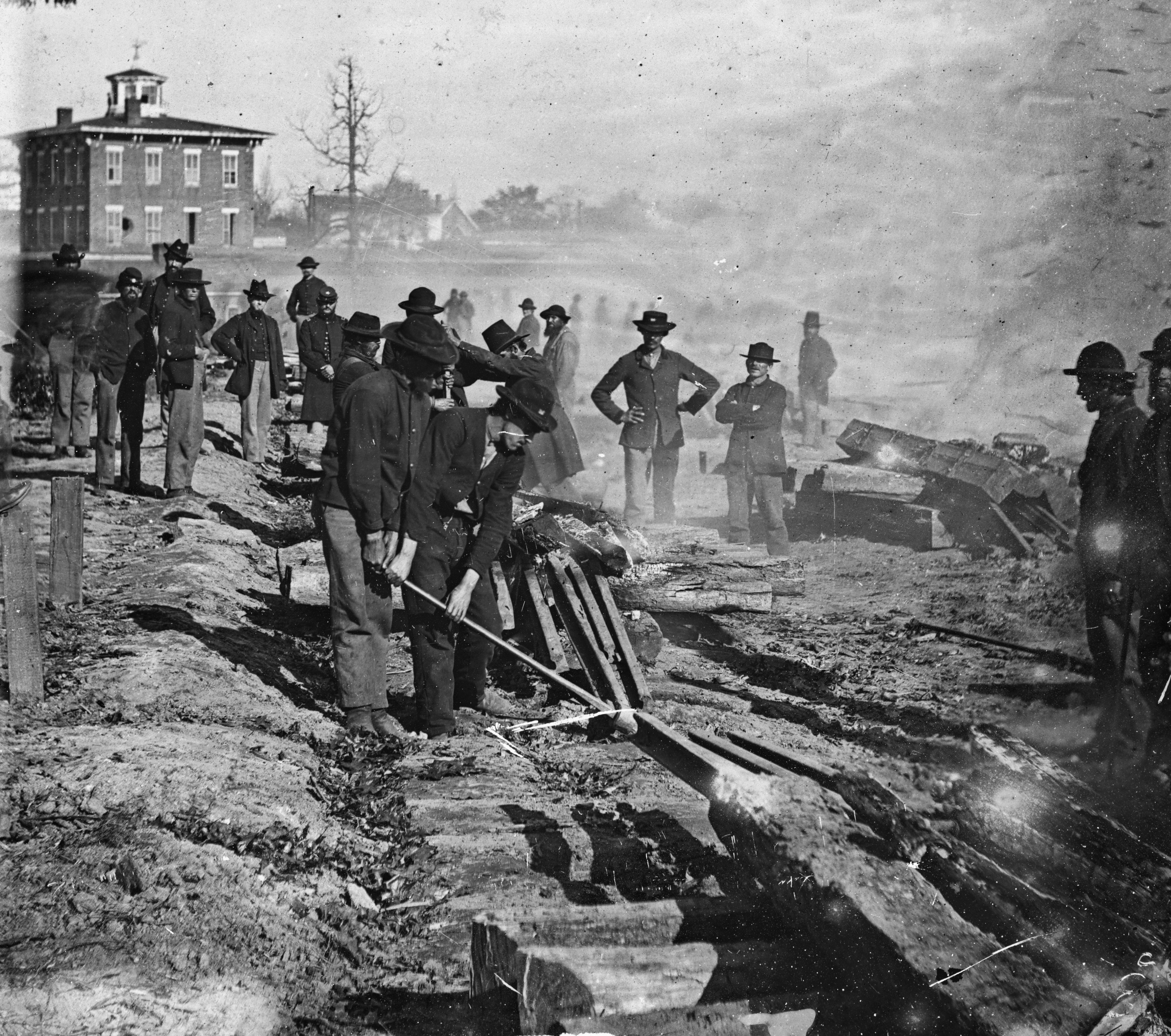Sherman's neckties on:
[Wikipedia]
[Google]
[Amazon]
 Sherman's neckties were a railway-destruction tactic used in the
Sherman's neckties were a railway-destruction tactic used in the
Sherman's Neckties
*{{Youtube, KMrUBFDYe0U, General Sherman and Total War: Sherman's Neckties, a demonstration by Civil War re-enactors. 1864 in the United States 1864 in Georgia (U.S. state) Georgia (U.S. state) in the American Civil War History of rail transportation in the United States Rail transportation in Georgia (U.S. state)
 Sherman's neckties were a railway-destruction tactic used in the
Sherman's neckties were a railway-destruction tactic used in the American Civil War
The American Civil War (April 12, 1861May 26, 1865; also known by Names of the American Civil War, other names) was a civil war in the United States between the Union (American Civil War), Union ("the North") and the Confederate States of A ...
. Named after Maj. Gen. William Tecumseh Sherman
William Tecumseh Sherman ( ; February 8, 1820February 14, 1891) was an American soldier, businessman, educator, and author. He served as a General officer, general in the Union Army during the American Civil War (1861–1865), earning recognit ...
of the Union Army, Sherman's neckties were railway
Rail transport (also known as train transport) is a means of transport using wheeled vehicles running in railway track, tracks, which usually consist of two parallel steel railway track, rails. Rail transport is one of the two primary means of ...
rails destroyed by heating them until they were malleable and twisting them into loops resembling neckties, often around trees. Since the Confederacy had limited supplies of iron, and few foundries to roll the rails, this destruction was very difficult to repair. They were also called Sherman's Bow Ties, Jeff Davis's Neckties, and Sherman Hairpins.
Although the destruction was ordered by Sherman during his Atlanta Campaign, the "necktie
A necktie, long tie, or simply a tie, is a cloth article of formal neckwear or office attire worn for decorative or symbolic purposes, resting under a folded shirt collar or knotted at the throat, and usually draped down the chest. On rare o ...
" shape formed by bending the rails around a tree was not; his orders specified a different method of track destruction which was not as popular:
After three days, only one Confederate railroad line leading into Atlanta
Atlanta ( ) is the List of capitals in the United States, capital and List of municipalities in Georgia (U.S. state), most populous city in the U.S. state of Georgia (U.S. state), Georgia. It is the county seat, seat of Fulton County, Georg ...
remained intact.
Sherman's neckties were also a feature of Sherman's March to the Sea, a campaign designed to bring hard war, or "serious destruction of infrastructure", to the Confederate States of America. Sherman implemented "scorched earth
A scorched-earth policy is a military strategy of destroying everything that allows an enemy military force to be able to fight a war, including the deprivation and destruction of water, food, humans, animals, plants and any kind of tools and i ...
" policies; he and Union Army commander Lt. Gen. Ulysses S. Grant believed that the Civil War would end only if the Confederacy's strategic, economic, and psychological capacities for warfare were decisively broken.
In the early days of the Franklin-Nashville Campaign of late 1864, the Confederates employed similar tactics against Sherman's supply line, the Western and Atlantic Railroad from Chattanooga
Chattanooga ( ) is a city in Hamilton County, Tennessee, United States, and its county seat. It is located along the Tennessee River and borders Georgia (U.S. state), Georgia to the south. With a population of 181,099 in 2020, it is Tennessee ...
to Atlanta. The rails deformed by fire were known to the soldiers of the Army of Tennessee
The Army of Tennessee was a Field army, field army of the Confederate States Army in the Western theater of the American Civil War, Western Theater of the American Civil War. Named for the Confederate States of America, Confederate state of Tenn ...
as "Old Mrs. Lincoln's Hair Pins."
See also
* Railroad plough * Rail sabotageReferences
External links
*Sherman's Neckties
*{{Youtube, KMrUBFDYe0U, General Sherman and Total War: Sherman's Neckties, a demonstration by Civil War re-enactors. 1864 in the United States 1864 in Georgia (U.S. state) Georgia (U.S. state) in the American Civil War History of rail transportation in the United States Rail transportation in Georgia (U.S. state)
Necktie
A necktie, long tie, or simply a tie, is a cloth article of formal neckwear or office attire worn for decorative or symbolic purposes, resting under a folded shirt collar or knotted at the throat, and usually draped down the chest. On rare o ...
Necktie
A necktie, long tie, or simply a tie, is a cloth article of formal neckwear or office attire worn for decorative or symbolic purposes, resting under a folded shirt collar or knotted at the throat, and usually draped down the chest. On rare o ...
Area denial weapons
Iron